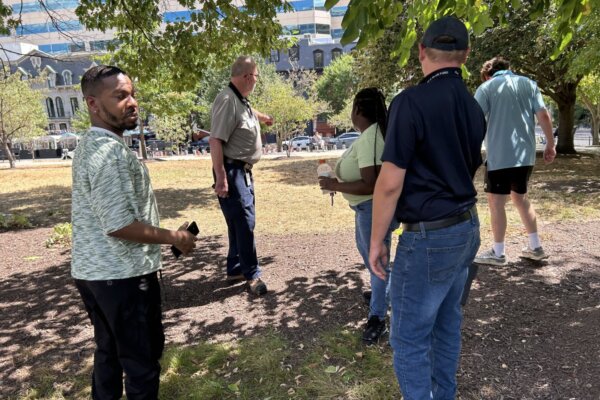Standing in a park across the street from Western Market in Northwest D.C., John Caffo and Jac Winters scrutinized a series of holes next to the concrete sidewalk.
This video is no longer available.
All of the evidence, they concluded, pointed to rat activity. On one side, there’s a wide gap between the ground and the edge of the sidewalk. Nearby, there’s a round hole.
After taking notes, Caffo and Winters continued to make their way around the park and another nearby, writing down any characteristics that may attract rodent activity: trash cans, litter and water sources, among others.
The “field trip” near George Washington University’s campus, an exercise with the goal of inspecting rodent infestations, came on the second day of D.C. Health’s two-day Rodent Control Academy. The event, first convened in 2006, teaches participants how rodents behave and best practices for managing them.
Caffo’s been learning about rodents for years, he said. Winters, a property manager, wanted to learn as much as he could about rats, to make sure they don’t end up in his buildings.
“They’re smart,” Winters said. “They’re going to find their way in one way or the other, but it’s my job to make sure they don’t get into our building.”
The seminar is put on by D.C. Health’s Rodent and Vector Control Team and Urban Rodentologist Bobby Corrigan.
Corrigan said the District is “afflicted with rats” the same way Philadelphia and New York City are.
The rodents are smart, he said, and know which areas have the best food. Traps or poison are only marginally helpful, according to Corrigan, who said the majority of solutions are tied to environmental management, such as taking out the trash and using the trash can correctly.
“It’s an animal that can get into a lot of trouble quickly,” Corrigan said. “It can get into ceilings and chewing wires, causing electrical shorts, and if not, worse, even building fires. It’s an animal that can carry bugs on his body that jump off the rats and go to people. … We have to fight back with some really intelligent pathways ourselves.”
One way to do that, Corrigan said, is understanding the way they behave. It’s one reason Advisory Neighborhood Commissioner Lynda Laughlin signed up for the academy. She represents an area in Adams Morgan that’s filled with businesses and restaurants.
She stressed the value of buying the right type of equipment, and “don’t do it cheap. Take a little bit of time to invest and fix the holes in your doorway,” Laughlin said.

But, the syllabus for the seminar called humans’ challenges with rodents “a forever war,” she said, so, “It’s just about if we can keep at bay the growing population, because they’re never gonna go away.”
Maxine Linthicum Davis, one of Amtrak’s senior health specialists for the southeast region, said she attended to try and “get ahead of the game.” She’s expecting some of the guidance to be helpful as Union Station gets revamped.
At a different park near 21st and I Streets, she leaned over a fence to take a picture of a hole hidden between bushes. Now that she’s observed rat tendencies, she’s planning to tell her colleagues the company needs rodent-proof door sweeps for gaps under doors.
“Sometimes I see things just like, ‘Wow, that’s pretty incredible,’ how they can go underneath the platform and end up from one side to the opposite side of the block type of deal. It’s pretty incredible,” Caffo said.
Get breaking news and daily headlines delivered to your email inbox by signing up here.
© 2024 WTOP. All Rights Reserved. This website is not intended for users located within the European Economic Area.








